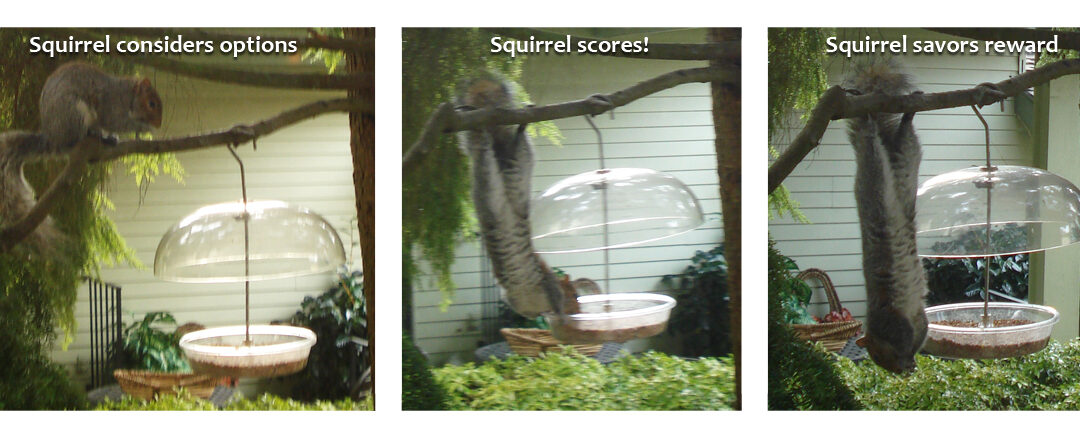This is a squirrel who knows how to handle fight-or-flight. Surely not all squirrels would be able to manage this elegant solution. How does she do it? First she sniffs that there are seeds for her lunch up in the tree. Then she goes up to get them, but Karen the owner has set up a barrier so she won’t be able to have any. She could run away in disgust at any point, but she doesn’t resort to flight. She could get frustrated and angry and scold loudly about it, but she doesn’t. She just sits there calmly and considers what options she has. Then she forms a plan and swings down around the plastic collar, snagging some seeds. Secure in her new skill, she chews on her seeds while she hangs in there by her toenails.
First handle, switch your self-talk
How can we humans hang in there when we’re frustrated in obtaining our immediate goals? We must refrain from quitting with flight or scolding with fight. We have an advantage over the squirrel because our larger Executive Brain can use words to help us manage our basic tendencies. Your Adult can listen to your inner self-talk in response to the problem. The kind of self-talk that triggers you into fight-or-flight sounds like this:
I can’t stand this! This is a disaster! This is unbearable! I can’t take this anymore! This is killing me! This makes me sick! This is unacceptable.
You can also notice your body begin to tense up with a tightening in your jaw, stomach, shoulders, brow or fists. You might feel light-headed, confused or even panicky, depending on your particular body’s stress reactions. Try to identify simple words like those above that are triggering you. You’ll discover you only have a few. Then challenge them quickly. I learned to say to myself, Stop lying to yourself and getting yourself all upset. Of course I can stand it; it won’t kill me. I just don’t want to stand it, I really don’t want to stand it, but I can. (fill in your favorite triggering phrase).
As I have noted, one stress reaction I experienced was panic attacks. These techniques also work for other fight-or-flight reactions like anxiety, anger, freezing or physical symptoms. I first discovered the power of this technique when I had to fight off panic attacks in the early 1970s. My Monkey Brain heard “I can’t stand it” as a signal to begin fight-or-flight, but not “I don’t want to stand it.” Switching the words would immediately shut off a panic attack. This allowed time for my Adult to monitor for a toxic belief or identify something in the situation that took me to this point.
Second handle, change your breathing
Another gift of my battle with panic attacks was my discovery about the role that breathing has in creating them and in shutting them down. Rapid, shallow breathing may be the earliest clue that your fight-or-flight process has begun. My favorite example of this is with my dachshund Dolly. At two months old she already demonstrated her hostility to all other dogs except our other dachshund, Henry. She would rush over to lunge for their throats, no matter how big they were. We learned to pick her up if we saw another dog and she’d struggle to get down and attack. She breathed with intense, rapid, shallow breaths to get oxygen into her muscles in preparation for the fight.
What I found for myself and my clients was that we wouldn’t notice our breathing had changed, even when our Adult was prepared to watch out for that. In the 1960s Claire Weeks had discovered that panic attacks occur when the carbon dioxide/oxygen balance in our brains is upset by the rapid shallow breathing of fight-or-flight. She advised people to breathe into a paper bag to decrease their oxygen level. I wanted an easier method so I began breathing out very long breaths. It went like this: long exhale, hold, brief inhale, then repeat until I was calm.
The squirrel could have spent her energy blaming Karen and scolded her good. In a human being that would be an expression of Toxic Belief #3, which is that when someone does something you don’t like they should be blamed and punished. But our squirrel’s instincts led her to conserve her energy and stay calm enough to get her food. We also need to stay out of fight-or-flight so we can best use our human skills to accomplish what we want to do.
Clients who’d been put on medication for years to prevent panic attacks were often skeptical. But these two handles allowed them to greatly reduce or get off their meds. You can use them for any fight-or-flight reaction you have. They all happen the same way. Engage your Adult to make sure your self-talk isn’t exaggerating the danger and breathe out instead of in when you feel stressed. You’ll achieve quick control for coping with temporary threats. You’ll still need to practice the FORMULA for long-term management of all the stress in your life though.

